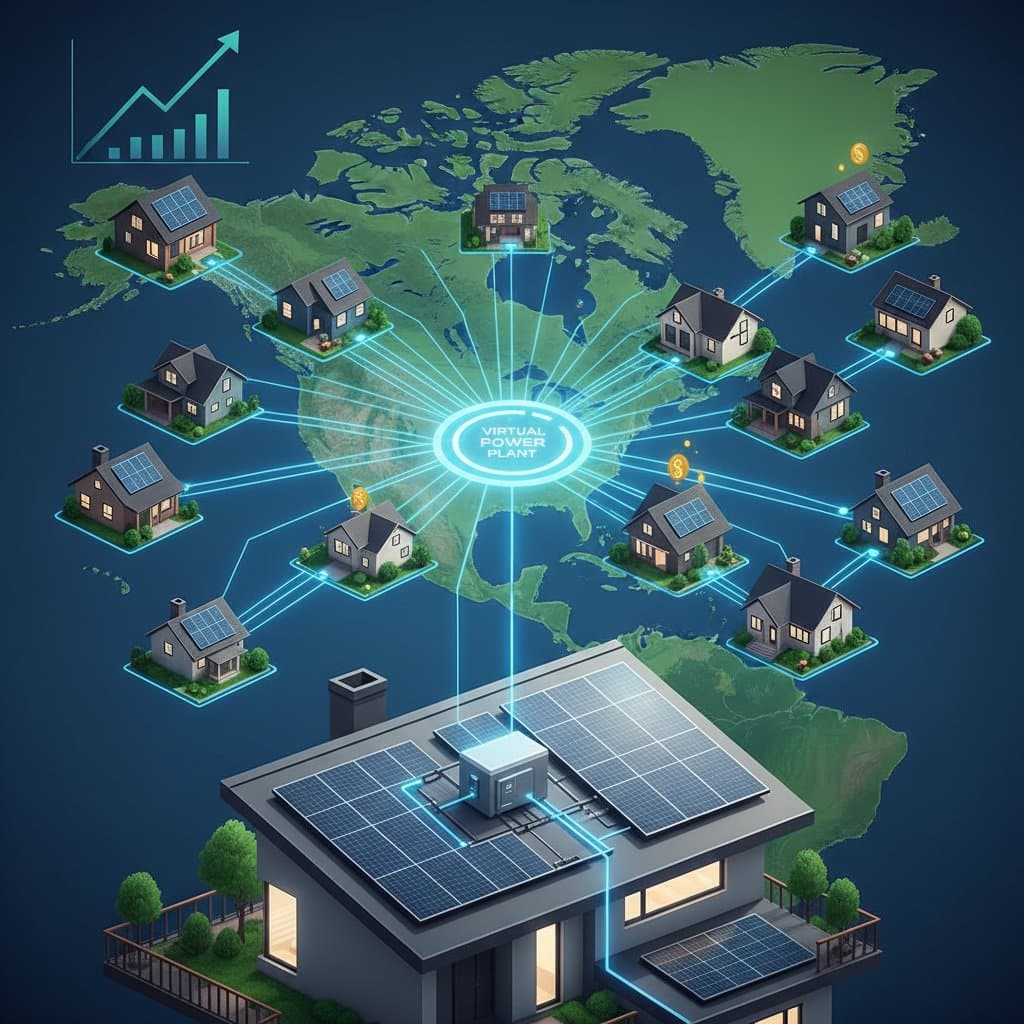Earn Up to $400 a Year Sharing Solar Energy Through Virtual Power Plants
Homeowners with solar panels now have an opportunity to generate additional income by participating in virtual power plants. These programs connect residential solar systems to a broader network that stabilizes the grid and promotes renewable energy integration. Participants typically earn around $400 annually, depending on system size and local conditions, while contributing to a more efficient energy infrastructure.
Virtual power plants aggregate distributed resources like rooftop solar, home batteries, and smart devices. Advanced software coordinates these assets in real time to mimic the output of a conventional power plant. This approach reduces emissions, lowers costs for utilities, and provides financial incentives for homeowners.
Understanding Virtual Power Plants
A virtual power plant operates by linking individual energy systems into a unified network. The central platform tracks production and consumption data from each participant. During grid stress, it directs systems to supply excess power or adjust usage, ensuring overall stability.
Homeowners join through an energy provider or dedicated operator. Eligible systems must feature compatible inverters or batteries that support secure communication. Once enrolled, the platform handles coordination, with compensation calculated based on contributed energy or flexibility.
Software algorithms distribute tasks evenly to avoid overburdening any single system. Participants access reports detailing their involvement and earnings. This transparency fosters trust and highlights the direct impact on grid reliability.
Financial Rewards for Participants
Earnings average $400 per year for typical setups, influenced by solar capacity, battery storage, and regional demand. Programs may offer fixed payments or tie incentives to market rates for services like peak shaving. This income supplements savings from self-generated electricity, enhancing the overall return on solar investments.
Payments arrive as utility credits or direct deposits, often quarterly. The process demands minimal effort after initial setup, as automation manages contributions. Beyond finances, participants support grid resilience by helping prevent outages and easing renewable integration.
How Utilities Benefit from Virtual Power Plants
Utilities manage increasing variability from solar and wind sources. Virtual power plants provide rapid response capabilities that traditional plants cannot match. They deploy distributed resources to balance supply and demand without relying on costly fossil fuels.
This model utilizes existing customer assets, deferring expensive infrastructure expansions. Utilities compensate participants for services that extend grid lifespan and improve efficiency. As a result, energy costs decrease for all consumers while renewable adoption accelerates.
Essential Technologies in Virtual Power Plants
Smart inverters regulate electricity flow, enabling precise grid interactions. Internet of Things connectivity allows real-time data exchange between devices and the platform. Cloud software analyzes patterns, forecasts needs, and issues commands for optimal performance.
Automated controls execute adjustments seamlessly, while analytics refine operations over time. These elements form a robust digital framework that transforms scattered resources into a cohesive power source. Compatibility with these technologies determines program eligibility.
Requirements for Joining a Virtual Power Plant
Systems need grid-tied solar panels with inverters supporting remote control standards. Battery storage enhances participation but is not always mandatory. A stable internet connection facilitates ongoing communication.
Homeowners agree to occasional dispatches during grid events, which last minutes to hours. Operators conduct compatibility checks and integrate software post-enrollment. Updates on performance arrive regularly, keeping participants informed.
Successful Virtual Power Plant Implementations
In solar-rich areas, virtual power plants address evening peaks by mobilizing stored energy. They deliver megawatts quickly during high-demand periods, averting disruptions. Residential users gain steady income and insights into their energy contributions via user dashboards.
Commercial entities with larger installations provide substantial support, boosting earnings potential. These examples demonstrate how virtual power plants scale to meet diverse grid challenges. Participants connect more deeply with sustainable energy efforts.
Environmental Advantages and Grid Enhancements
Virtual power plants minimize fossil fuel use by prioritizing renewables during peaks. They store or redirect surplus solar energy, avoiding waste. This reduces emissions and bolsters local air quality.
The coordinated response strengthens grid resilience against fluctuations. Integration with electric vehicles and smart appliances expands flexibility. Future expansions could include demand-side management for devices like heaters, further optimizing resources.
Steps to Start Earning with Virtual Power Plants
- Verify equipment compatibility by consulting your installer or manufacturer.
- Identify local programs through utility websites or aggregator platforms.
- Enroll online, providing system details for approval.
- Authorize software installation and complete testing.
- Track contributions and payments using app-based tools.
Setup concludes quickly, with systems running autonomously thereafter. Home needs always take precedence, ensuring uninterrupted service.
Resolving Typical Participant Questions
Concerns about autonomy arise, yet programs safeguard essential loads and limit interventions. Batteries maintain reserves for household use. Data security employs encryption, restricting access to operational necessities.
Detailed logs reveal event specifics, promoting accountability. These measures address privacy and reliability issues effectively. Participants report high satisfaction with the balanced approach.
Expanding Opportunities in Distributed Energy
Virtual power plants signal a shift to decentralized systems as technologies advance. Declining costs and improved software draw more participants. Utilities enhance platforms for broader management.
Installers incorporate virtual power plant readiness into offerings. Regulators introduce supportive policies, easing adoption. This growth benefits homeowners, providers, and the energy sector alike.
Outlook for Virtual Power Plant Growth
Compensation may rise with dynamic markets and better forecasting. Vehicle-to-grid features will unlock earnings from EV batteries. Standardized protocols simplify integration across devices.
These developments position virtual power plants as central to future grids. Solar owners maximize value while aiding sustainability.
Maximizing Returns Through Active Participation
Joining a virtual power plant elevates solar ownership from cost savings to revenue generation. The $400 annual earning potential underscores tangible rewards. Equally important are contributions to a stable, clean energy landscape that benefits communities.
